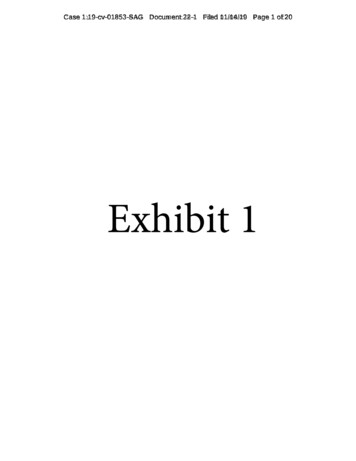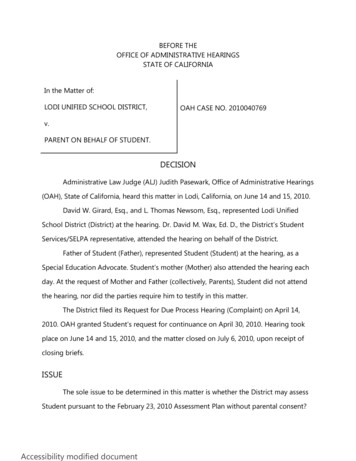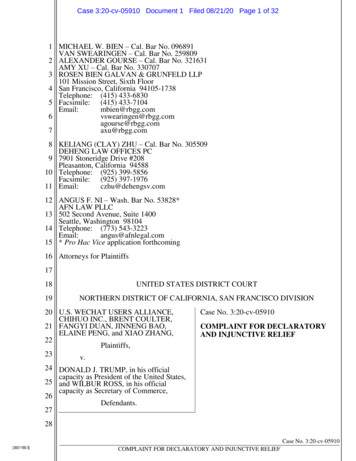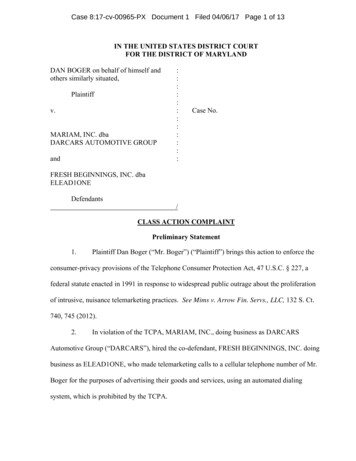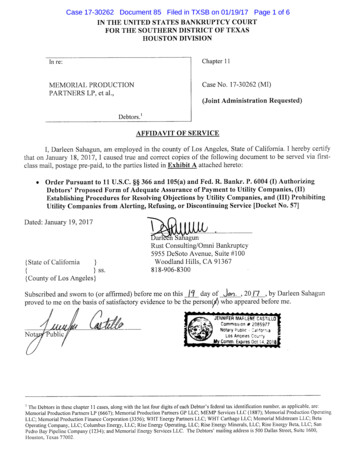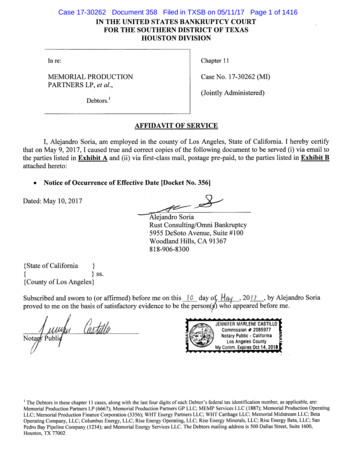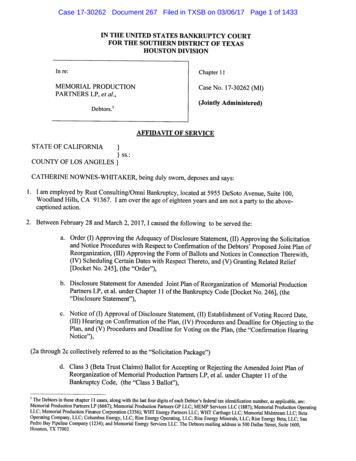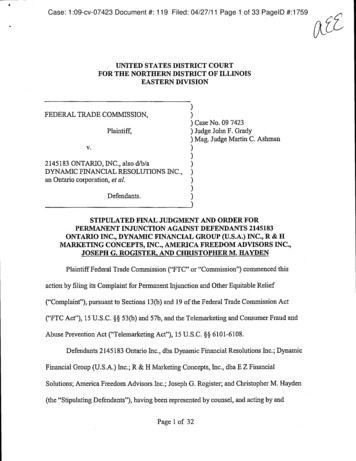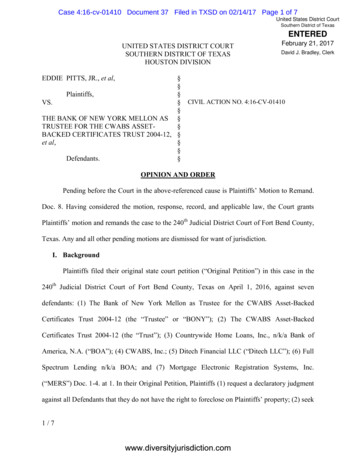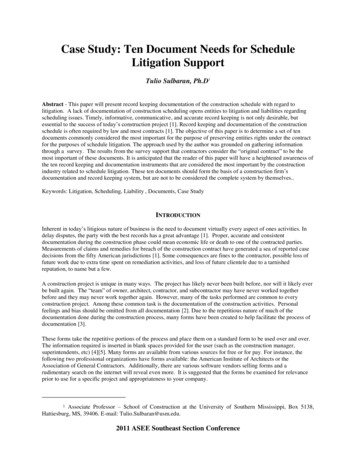
Transcription
Case Study: Ten Document Needs for ScheduleLitigation SupportTulio Sulbaran, Ph.D1Abstract - This paper will present record keeping documentation of the construction schedule with regard tolitigation. A lack of documentation of construction scheduling opens entities to litigation and liabilities regardingscheduling issues. Timely, informative, communicative, and accurate record keeping is not only desirable, butessential to the success of today’s construction project [1]. Record keeping and documentation of the constructionschedule is often required by law and most contracts [1]. The objective of this paper is to determine a set of tendocuments commonly considered the most important for the purpose of preserving entities rights under the contractfor the purposes of schedule litigation. The approach used by the author was grounded on gathering informationthrough a survey. The results from the survey support that contractors consider the “original contract” to be themost important of these documents. It is anticipated that the reader of this paper will have a heightened awareness ofthe ten record keeping and documentation instruments that are considered the most important by the constructionindustry related to schedule litigation. These ten documents should form the basis of a construction firm’sdocumentation and record keeping system, but are not to be considered the complete system by themselves.Keywords: Litigation, Scheduling, Liability , Documents, Case StudyINTRODUCTIONInherent in today’s litigious nature of business is the need to document virtually every aspect of ones activities. Indelay disputes, the party with the best records has a great advantage [1]. Proper, accurate and consistentdocumentation during the construction phase could mean economic life or death to one of the contracted parties.Measurements of claims and remedies for breach of the construction contract have generated a sea of reported casedecisions from the fifty American jurisdictions [1]. Some consequences are fines to the contractor, possible loss offuture work due to extra time spent on remediation activities, and loss of future clientele due to a tarnishedreputation, to name but a few.A construction project is unique in many ways. The project has likely never been built before, nor will it likely everbe built again. The “team” of owner, architect, contractor, and subcontractor may have never worked togetherbefore and they may never work together again. However, many of the tasks performed are common to everyconstruction project. Among these common task is the documentation of the construction activities. Personalfeelings and bias should be omitted from all documentation [2]. Due to the repetitious nature of much of thedocumentation done during the construction process, many forms have been created to help facilitate the process ofdocumentation [3].These forms take the repetitive portions of the process and place them on a standard form to be used over and over.The information required is inserted in blank spaces provided for the user (such as the construction manager,superintendents, etc) [4][5]. Many forms are available from various sources for free or for pay. For instance, thefollowing two professional organizations have forms available: the American Institute of Architects or theAssociation of General Contractors. Additionally, there are various software vendors selling forms and arudimentary search on the internet will reveal even more. It is suggested that the forms be examined for relevanceprior to use for a specific project and appropriateness to your company.1Associate Professor – School of Construction at the University of Southern Mississippi, Box 5138,Hattiesburg, MS, 39406. E-mail: Tulio.Sulbaran@usm.edu.2011 ASEE Southeast Section Conference
Thus, the objective of this paper is to determine which of the many available documents/forms are considered byconstruction companies the ten most important for the purpose of preserving entities rights during schedulelitigation.PROJECT APPROACHThe research team initiated this project by doing a literature review of the construction documents used in support ofschedule litigations. The result of the literature review was not meant to be an exhaustive list of documents, butrather commonly referenced documents in the literature. The list of these documents with a short description isprovided in Table 1:Table 1. Scheduling Documents/FormsDocumentID1Document NameDocument DescriptionA Filing Record of all theRecord Files that arebeing maintainedAn Index, of sorts, of the method used to keep track of thevarious documents.2Progress photographs3Progress Reports, weekly,monthly or quarterlyNotes of telephoneconversationsMilestone photographs, photograph each milestone anddocument the date and time of completionReporting the progress of the project according to milestones orjust the overall completion according to the scheduleAny telephone conversations that might be of any importancebetween two contractors or the owner and a contractor, thatmight be involving changesKeeping record of what was done and completed in a writtenformPerhaps the most critical contract term relating to delay claimsis notice of claims. Most contracts contain provisions with aspecific deadline for submission of claims. Failure to adhere tothe requirements of notice of claims may eliminate your claimbefore you even raise it.Information that may be needed by a certain contractor orsubcontractor of the projectAll pages of the original contract456Daily diary or journalentriesNotice of claims fordelays and/or extra costby contractor7Requests for information8The original contractdocumentThe issued forconstruction setThe Instructions tocontractor documentSub-contractor quotes,contracts, purchase ordersand correspondenceShop drawings, originals,all revisions and resubmissions9101112The set of blueprints as agreed upon by the owner and architectas awarded to the contractor during the bid phaseIncludes any special instructions for the contractor such asprotection of existing vegetation and suchSelf explanatoryA drawing or set of drawings produced by the contractor,supplier, manufacturer, subcontractor, or fabricator. Shopdrawings are not produced by architects and engineers undertheir contract with the owner. The shop drawing is themanufacturers’ or the contractor’s drawn version of informationshown in the construction documentsTable 1 Continuous on Next Page2011 ASEE Southeast Section Conference
Continuation Table 1 Previous PageDocumentID1314151617181920212223Document NameDocument DescriptionShop drawingtransmittals, andtransmittals logDaily time recordsDaily production logsMaterial Delivery andUse RecordsProgress PaymentBillings under thecontractDaily Force AccountRecords, pricing andbillingsContract MilestoneSchedule or MasterScheduleTask schedules andanalysesA submittal that goes along with the submission of the shopdrawings that informs the reader or the importanceProductivityReports/AnalysesMinutes of ContractualMeetingsMinutes of SiteCoordination MeetingsRecord of time spent on the jobsite dailyThe record of the production that each day on the site providesRecords of the receiving date of materials from suppliers andequipment contractorsInterim payment for delivered work in accordance with contractterms generally tied to meeting specified performancemilestonesA set of records showing how many workmen have worked,their cost and their billing of the workSchedule showing major project tasks and their completion dateanalysis of how a task is accomplished, including a detaileddescription of both manual and mental activities, task andelement durations, task frequency, task allocation, taskcomplexity, environmental conditions, necessary clothing andequipment, and any other unique factors involved in or requiredfor one or more people to perform a given taskShows the hours that were worked and the percentage that isbillableAny meeting notes that are taken during contract meetingNotes from the site coordination meetingsAfter identifying the list of documents/forms the research team prepared a survey. The survey had two parts: 1Demographic information and 2- Scheduling related documents. The Scheduling related documents part relied onthe documents/forms list discussed above. The complete survey is provided in Appendix A.Finally, the research team contacted 50 construction firms throughout the continental United States. Each of thefirms contacted was chosen based upon the number of years in business. Firms had to be established for at least tenyears in order to qualify for this study. To better ensure cooperation with this project, the research team firstcontacted the company by telephone. The survey was then delivered via the most desirable method of the firm incontact, either email, fax or ground mail. The research team ended the quest of construction firms once tenresponses were received. These returned surveys were then compiled and mined for commonalities. Thecommonalities are reported below.2011 ASEE Southeast Section Conference
RESULTSOut of the fifty construction companies that were initially identified for this project, forty companies were sent thesurvey. Out of the forty companies that received the survey ten responses were received for a return rate of pondents80%Figure 1. Survey Response PercentageDEMOGRAPHICSSeven of the respondents said their main business is residential construction. Three of the respondents said theirmain business is commercial.Heavy Civil0%Commercial30%CommercialResidentialHeavy CivilResidential70%Figure 2. Type of Business2011 ASEE Southeast Section Conference
Three of the respondents were from the state of Idaho. Six were from Mississippi and one was from Florida.Figure 3. Geographical Location of RespondentsThe average years in business of all respondents are 22.35 with a maximum of 32 and a minimum of 12 years.109Survey Respondents876Series15432105101520253035Years in BusinessFigure 4. Respondent Years in BusinessSeven of the respondents declared that their approximate 2006 revenue was under 5 million dollars, while the otherthree claimed to make over 21 million dollars in 2006.2011 ASEE Southeast Section Conference
20MM x 15MM x 20MM 10MM x 15MMSeries1 5MM x 10MM 5MM2006 Revenue02468Figure 5. Respondent 2006 RevenueIn order to find the ten most common scheduling documents, the research team first recorded each survey’s ratingsinto an Excel spreadsheet. The team was then able to calculate the average response of each document. After thiscalculation, the team developed a chart showing the average of each document response, with the highest averagesportraying the most important documentation.The average response for each of the document types is found in Figure 6. From these averages, one may inferwhich documents were deemed most important.Figure 6. Respondent Document Rating Average2011 ASEE Southeast Section Conference
The results of the survey show the following ten documents as being deemed the most important by our surveyrespondents.Document NumberDocument DescriptionAverage8Original Contract Documents911Contractor Quotes, Contracts, Purchase Orders, andCorrespondence6.612Shop Drawings, Original, Revisions, Resubmissions5.719Contract Milestone Schedule, or Master Schedule5.71Filing Record of All Documents being Maintained4.510Instructions to Contractor4.522Minutes of Contractual Meetings4.113Shop Drawing Transmittals, and Transmittal Log7Request for Information3.95Daily Diary or Journal Entries3.54CONCLUSIONA lack of documentation of construction scheduling opens entities to litigation and liabilities regarding schedulingissues. Timely, informative, communicative and accurate record keeping is not only desirable, but essential to thesuccess of today’s construction project [1]. Record keeping and documentation of the construction schedule is oftenrequired by law and most contracts. The objective of this paper was to determine a set of ten commonly consideredthe most important documents for the purpose of preserving entities rights under the contract for the purposes oflitigation. We created a survey of common construction documents and delivered these to 50 companies. Asexpected, 20% returned the surveys. From these returned surveys we determined a list of ten documents deemedmost important to construction professionals.We found our top-ten list included only four of the documents listed by our respondents. These were Documents 8Original Contract Documents, 10 Instructions to the Contractor, 11 Contractor Quotes, Contracts, Purchase Orders,and Correspondence, and 19 the Contract Milestone Schedule, or Master Schedule. No correlation regardingdemographic information collected such as type of business, years in business and revenue could be determinedregarding the choices made by the respondents as to which documents were most important.ACKNOWLEDGEMENTThe author would like to acknowledge the students that help in the preparation and the data collection of this project.2011 ASEE Southeast Section Conference
REFERENCES[1] Sweet, Justin (1989). Legal aspects of architecture engineering and the construction process: 4th edition. St.Paul, MN: West Publishing Company.[2] Poulin, Thomas A. (1985). Avoiding contract disputes. New York, NY: ASCE. (Poulin, 1985)[3] Ricchini, J, & O'Brien, J (1990). Construction documentation: 2nd edition.Eau Claire, WI: PESI. (Ricchini andO'Brien, 1990)[4] Poage, Waller S. (2000). The building professional's guide to contract documents: 3rd edition. Kingston, MA:RSMeans. (Poage, 2000)[5] Widman, M (1990). Construction claims identification, communication and record keeping. Retrieved October25, 2007, from Expert Project Management Web site: o.htm2011 ASEE Southeast Section Conference
Appendix ASurvey of the Ten Most Important Construction Scheduling Documentswith Regard to LitigationOverview: We would like to ask you to fill out this survey. The purpose of this survey is to determine the10 most important construction scheduling record keeping documents.Disclosure: Your contact information will not be shared with any one. The information will be groupedto provide statistical information regarding the objective of this study.Instructions: Please answer the questions below to the best of your abilities.1- DEMOGRAPHIC101- Name: 102- Position:103- Company Name:104- Main Business: [ ] Commercial[ ] Residential[ ] Heavy Civil105- City: 106- State:107- Phone Number: 108- Email:109- Number of Years in Business:110- Approximate 2006 Revenue:[ ] Less than 5 MM[ ] 16- 20MM[ ] 6 MM – 10 MM[ ] 11 MM – 15MM[ ] 21 MM or more2- SCHEDULING RELATED DOCUMENTSFrom the following list of 23 common record keeping processes and documentation instruments, rank the10 you deem most important from 1 to 10 with 10 being the most important.[ ] A Filing record of all the documents that are being maintained[ ] Progress photographs[ ] Progress reports, weekly, monthly or quarterly[ ] Notes of telephone conversations[ ] Daily diary or journal entries[ ] Notice of claims for delay and/or extra cost by contractor[ ] Requests for information[ ] Original Contract Documents[ ] Issued for Construction set, and all subsequent revisions[ ] Instructions to contractor[ ] Sub-contractor quotes, contracts, purchase orders and correspondence[ ] Shop drawings, originals, all revisions and re-submissions[ ] Shop drawing transmittals, and transmittals log[ ] Daily time records[ ] Daily production logs, e.g. concrete pours etc.2011 ASEE Southeast Section Conference
[[[[[[[[] Material Delivery and Use Records, including expediting] Progress Payment Billings under the contract] Daily Force Account Records, pricing and billings] Contract Milestone Schedule or Master Schedule] Task schedules and analyses] Productivity Reports/Analyses] Minutes of Contractual Meetings] Minutes of Site Coordination MeetingsComments:2011 ASEE Southeast Section Conference
Keywords: Litigation, Scheduling, Liability , Documents, Case Study INTRODUCTION Inherent in today’s litigious nature of business is the need to document virtually every aspect of ones activities. In delay disputes, the party with the best records h
